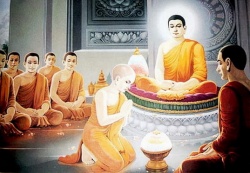Difference between revisions of "Gihwa"
| Line 1: | Line 1: | ||
[[File:13sd.jpg|thumb|250px|]] | [[File:13sd.jpg|thumb|250px|]] | ||
| − | [[Gihwa]] ({{Wiki|hangul}}: 기화 {{Wiki|hanja}}: 己和, 1376–1433), also known as [[Hamheo Teuktong]] was a [[Buddhist]] [[monk]] of the [[Seon]] order and leading [[Buddhist]] figure during the late {{Wiki|Goryeo}} to early {{Wiki|Joseon}} period. He was originally a {{Wiki|Confucian}} {{Wiki|scholar}} of high reputation, but converted to [[Buddhism]] at the age of 21 upon the [[death]] of a close friend. He wandered among the {{Wiki|Korean}} mountain [[monasteries]], until he had the fortune of becoming the disciple of the last Korean {{Wiki|National Teacher}} {{Wiki|Muhak}}. | + | [[Gihwa]] ({{Wiki|hangul}}: 기화 {{Wiki|hanja}}: 己和, 1376–1433), also known as [[Hamheo Teuktong]] was a [[Buddhist]] [[monk]] of the [[Seon]] [[order]] and leading [[Buddhist]] figure during the late {{Wiki|Goryeo}} to early {{Wiki|Joseon}} period. He was originally a {{Wiki|Confucian}} {{Wiki|scholar}} of high reputation, but converted to [[Buddhism]] at the age of 21 upon the [[death]] of a close [[friend]]. He wandered among the {{Wiki|Korean}} mountain [[monasteries]], until he had the [[fortune]] of becoming the [[disciple]] of the last [[Korean]] {{Wiki|National Teacher}} {{Wiki|Muhak}}. |
| − | [[Gihwa]]'s writings showed a distinctive mixture between iconoclastic and suddenistic [[Chán]] language, and a strong appreciation for the scriptural [[tradition]]. Thus, he took up from Jinul the tradition of unification of {{Wiki|Seon and Gyo}} [[Buddhism]]. Among his writings, there are four works in particular that made a deep impact on the subsequent [[Seon]] [[tradition]] in {{Wiki|Korea}}. These are: | + | [[Gihwa]]'s writings showed a {{Wiki|distinctive}} mixture between iconoclastic and suddenistic [[Chán]] [[language]], and a strong [[appreciation]] for the scriptural [[tradition]]. Thus, he took up from [[Jinul]] the [[tradition]] of unification of {{Wiki|Seon and Gyo}} [[Buddhism]]. Among his writings, there are four works in particular that made a deep impact on the subsequent [[Seon]] [[tradition]] in {{Wiki|Korea}}. These are: |
* A commentary on the [[Sutra of Perfect Enlightenment]], the [[Weongak gyeong hae seorui]]. | * A commentary on the [[Sutra of Perfect Enlightenment]], the [[Weongak gyeong hae seorui]]. | ||
* A redaction and subcommentary to five famous earlier commentaries on the [[Diamond Sutra]], the [[Geumgang banyabaramilgyeong ogahae seorui]]. | * A redaction and subcommentary to five famous earlier commentaries on the [[Diamond Sutra]], the [[Geumgang banyabaramilgyeong ogahae seorui]]. | ||
* A subcommentary and redaction of the Collection of Yongjia, the Yonggajip gwaju seorui and | * A subcommentary and redaction of the Collection of Yongjia, the Yonggajip gwaju seorui and | ||
| − | * The {{Wiki|Hyeonjeong non}}. As a result of his fourth major work (the {{Wiki|Hyeonjeong non}}) [[Gihwa]] distinguished himself as the primary [[Buddhist]] respondent to the rising {{Wiki|Neo-Confucian}} polemic of his period, as he responded with vigor to the {{Wiki|Neo-Confucian}} criticisms of [[Buddhism]]. | + | * The {{Wiki|Hyeonjeong non}}. As a result of his fourth major work (the {{Wiki|Hyeonjeong non}}) [[Gihwa]] distinguished himself as the [[primary]] [[Buddhist]] respondent to the rising {{Wiki|Neo-Confucian}} polemic of his period, as he responded with [[vigor]] to the {{Wiki|Neo-Confucian}} criticisms of [[Buddhism]]. |
| − | [[Gihwa]] died while residing at Jeongsusa, at the southern tip of {{Wiki|Ganghwa Island}}, where his tomb can still be visited. [[Gihwa]]'s commentary on the [[Sutra of Perfect Enlightenment]] was translated by {{Wiki|A. Charles Muller}}, in 1999. | + | [[Gihwa]] [[died]] while residing at Jeongsusa, at the southern tip of {{Wiki|Ganghwa Island}}, where his tomb can still be visited. [[Gihwa]]'s commentary on the [[Sutra of Perfect Enlightenment]] was translated by {{Wiki|A. Charles Muller}}, in 1999. |
| − | Essence-Function (體用) is a key concept in {{Wiki|East Asian}} [[Buddhism]] and particularly that of {{Wiki|Korean}} [[Buddhism]]. Essence-Function takes a particular form in the [[philosophy]] and writings of Kihwa | + | [[Essence-Function]] ([[體用]]) is a key {{Wiki|concept}} in {{Wiki|East Asian}} [[Buddhism]] and particularly that of {{Wiki|Korean}} [[Buddhism]]. [[Essence-Function]] takes a particular [[form]] in the [[philosophy]] and writings of Kihwa |
{{W}} | {{W}} | ||
[[Category:Korea]] | [[Category:Korea]] | ||
Revision as of 10:07, 5 October 2013
Gihwa (hangul: 기화 hanja: 己和, 1376–1433), also known as Hamheo Teuktong was a Buddhist monk of the Seon order and leading Buddhist figure during the late Goryeo to early Joseon period. He was originally a Confucian scholar of high reputation, but converted to Buddhism at the age of 21 upon the death of a close friend. He wandered among the Korean mountain monasteries, until he had the fortune of becoming the disciple of the last Korean National Teacher Muhak.
Gihwa's writings showed a distinctive mixture between iconoclastic and suddenistic Chán language, and a strong appreciation for the scriptural tradition. Thus, he took up from Jinul the tradition of unification of Seon and Gyo Buddhism. Among his writings, there are four works in particular that made a deep impact on the subsequent Seon tradition in Korea. These are:
- A commentary on the Sutra of Perfect Enlightenment, the Weongak gyeong hae seorui.
- A redaction and subcommentary to five famous earlier commentaries on the Diamond Sutra, the Geumgang banyabaramilgyeong ogahae seorui.
- A subcommentary and redaction of the Collection of Yongjia, the Yonggajip gwaju seorui and
- The Hyeonjeong non. As a result of his fourth major work (the Hyeonjeong non) Gihwa distinguished himself as the primary Buddhist respondent to the rising Neo-Confucian polemic of his period, as he responded with vigor to the Neo-Confucian criticisms of Buddhism.
Gihwa died while residing at Jeongsusa, at the southern tip of Ganghwa Island, where his tomb can still be visited. Gihwa's commentary on the Sutra of Perfect Enlightenment was translated by A. Charles Muller, in 1999.
Essence-Function (體用) is a key concept in East Asian Buddhism and particularly that of Korean Buddhism. Essence-Function takes a particular form in the philosophy and writings of Kihwa
